How Many New Monitor Discoveries for 2010?
Posted by: Loren Coleman on June 5th, 2010
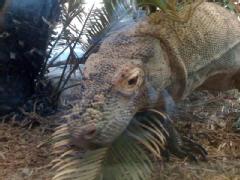
Today, the Cincinnati Zoo will open their new Komodo dragon exhibit and show off “Hudo,” a new Komodo dragon (above) given to them by the Indianapolis Zoo. The seven-year-old Hudo weighs 100 pounds and is seven feet long and according to Dave Jenike, vice-president of the Cincinnati Zoo, has a lot of growing to do.
It appears the genus of lizards encompassing Hudo is having a growth spurt of its own this year.
Some new animals found are Komodo dragon relatives, including one new six-foot-long monitor lizard hiding in plain sight, which may turn out to be the largest species find of 2010. While, technically, the discovery of even one of these should have gotten as much publicity as a Bigfoot being found at a Starbucks in Seattle, the coverage of so many new monitors has been underwhelming.
The news has been coming in disjointed bits and pieces, so it has been somewhat confusing in its presentation. Large monitor lizards have been literally and metaphorically falling out of the trees of the tropics and the natural history museums of Europe, being “discovered” (verified by science) this year, in high numbers.
But it probably hasn’t helped that they are reptiles, and not cuddly, media-friendly mammals. Add to that there’s been so many different species found, and one can understand why this news is only making the back pages.
Three new Philippine monitors were identified, for example, solely based on examination of numerous preserved voucher specimens in various major European natural history museums, in combination with long-term studies in the field. Not exactly the kind of breaking news that makes it on your television screen at night, pushing out those car chases and BP underwater camera shots of oil pouring into the ocean, humm?
But then there was the huge discovery from Luzon, of the fruit-eating giant monitor.
Eric Pianka, one of the world’s foremost experts on Varanus lizards, an integrative biologist at the University of Texas at Austin, told the media that this “new monitor lizard is indeed exciting. Who would have ever guessed that a 6-foot-long lizard could go undescribed until 2010? This truly is major news!”
But it really seems no one in the media was listening. Well, except at Cryptomundo and a few outlets of the enlightened, ha.
It might be helpful to sort these new monitor discoveries out today.
Here’s a list of what’s been found:

1) The biggest new monitor, named the Northern Sierra Madre Forest Monitor Lizard, is 6 feet long, around 22 pounds and brightly colored yellow and black. It is in the same family as the Komodo dragon, the world’s largest lizard.
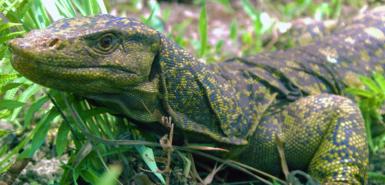
Named Varanus bitatawa, this newly discovered species, decorated in stripes of gold flecks and armed with huge, curved claws for climbing trees, is one of only three fruit-eating monitor species in the world.
“Rumors of its existence and some clues have floated around among biologists for the past 10 years,” said co-author Rafe Brown, an assistant professor in the Department of Ecology and Evolutionary Biology at the University of Kansas, and curator of herpetology at the university’s Biodiversity Institute.
“People had taken photographs of hunters from the resident tribespeople as they were carrying the reptiles back to their homes to feed their families in 2001,” said Brown.
This, of course, means it was ethnoknown and thus a cryptozoological find, as have been some of the others. (See more, here.)
2) One of the three new “museum found” species from the Philippines, Varanus rasmusseni, was identified based on only two specimens housed at the Zoological Museum of Copenhagen in Denmark. V. rasmusseni juveniles are distinguished by a unique pattern of small, tiny bright dots on their backs, said the study’s lead author André Koch of the University of Bonn in Germany.
“After the spectacular discovery of several new monitor lizards from the Indonesian island of Sulawesi three years ago, our results now illustrate that the diversity of water monitor lizards in the Philippines has also been largely underestimated,” said German scientist Koch.
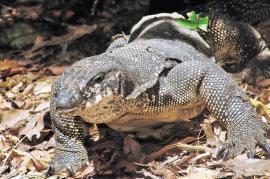
3) Another one from Koch’s study was the new species named Varanus palawanensis, which displays white, irregularly shaped splotches on its head. The above image of this species is from Ingo Langlotz.
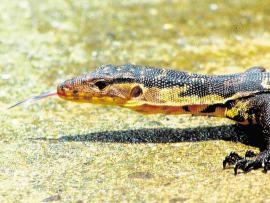
4) Koch’s study also identified a new subspecies, Varanus cumingi samarensis, which has a much darker color pattern than its bright yellow relatives. It is shown directly above, in this photo from Maren Gaulke.
Koch together with his supervisor Dr. Wolfgang Boehme and another colleague described these three species mentioned above in Zootaxa, the world’s foremost journal for taxonomic zoology.
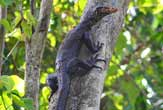
5) The newly discovered Varanus obor (aka the Sago monitor, or Torch monitor lizard) was discovered in Indonesia. It can grow to nearly 4 feet (1.2 meters) in length and 3.5 pounds (1.5 kilograms) in weight, and eats small animals and carrion. The Torch monitor exists only on the small island of Sanana in the western Moluccan islands of Indonesia. It has a bright orange head with a glossy black body. “Obor” means torch in Indonesian. (See more, here.)
Was there a sixth one? Or is there another one waiting in the wings? Probably.
You may recall that in 2009, the following monitor lizard was discovered.
The above new monitor lizard species was discovered on the Talaud Islands in Indonesia by German scientist André Koch, during the course of a joint German-Indonesian research project. The new species was identified by using morphological characteristics and DNA analysis. Varanus lirungensis was described in the Australian Journal of Zoology.
So, let’s see, just for Varanus salvator, the water monitor, it is in the process of being split into a number of species restricted to specific island groups. In the Philippines, the following are now recognized:
Varanus cumingi cumingi [already recognized] – Greater Mindanao subregion
Varanus cumingi samarensis [new] – East Visayan subregion
Varanus nuchalis [already recognized] –
Varanus marmoratus [elevated from subspecies] –
Varanus rasmusseni [new, split from marmoratus] – Sulu archipelago
Varanus palawanensis [new, split from marmoratus] – Palawan
More confused?
Can you imagine a news reporter trying to tackle this and making it exciting, breaking news?
About Loren Coleman
Loren Coleman is one of the world’s leading cryptozoologists, some say “the” leading living cryptozoologist. Certainly, he is acknowledged as the current living American researcher and writer who has most popularized cryptozoology in the late 20th and early 21st centuries.
Starting his fieldwork and investigations in 1960, after traveling and trekking extensively in pursuit of cryptozoological mysteries, Coleman began writing to share his experiences in 1969. An honorary member of Ivan T. Sanderson’s Society for the Investigation of the Unexplained in the 1970s, Coleman has been bestowed with similar honorary memberships of the North Idaho College Cryptozoology Club in 1983, and in subsequent years, that of the British Columbia Scientific Cryptozoology Club, CryptoSafari International, and other international organizations. He was also a Life Member and Benefactor of the International Society of Cryptozoology (now-defunct).
Loren Coleman’s daily blog, as a member of the Cryptomundo Team, served as an ongoing avenue of communication for the ever-growing body of cryptozoo news from 2005 through 2013. He returned as an infrequent contributor beginning Halloween week of 2015.
Coleman is the founder in 2003, and current director of the International Cryptozoology Museum in Portland, Maine.

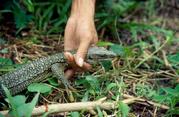









If I believed in luck I’d say now would be a good time to go track down Megalania.
See this is hard evidence that large animals can still remained undiscovered. I agree with D2K4 that maybe living Megalanias aren’t so unrealistic now!